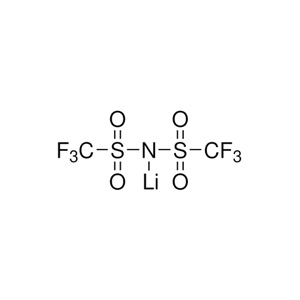Aure Chemical: Your Trusted Source for High-Purity Lithium TFSI (LiTFSI, CAS 90076-65-6)
Aure Chemical is a premier global supplier of high-quality Lithium TFSI, commonly known as LiTFSI. Identified by its CAS number 90076-65-6, LiTFSI is a white crystalline powder renowned as an advanced electrolyte salt. Its unique combination of properties—including exceptional thermal stability, high electrochemical stability (even at elevated temperatures), excellent ionic conductivity, and a broad electrochemical window—makes it a superior alternative to conventional electrolyte salts like LiPF6. LiTFSI is indispensable for developing high-performance and safer lithium-ion batteries, particularly for electric vehicles and grid-scale energy storage. It also plays a vital role in emerging solid-state battery technologies and the formulation of novel ionic liquids for various electrochemical applications. Aure Chemical is committed to providing LiTFSI that meets stringent purity and performance requirements, ensuring consistent and reliable results for your most demanding industrial and research applications. Partner with us for a dependable supply of this critical chemical.
Basic Information of Lithium Bis(trifluoromethanesulfonyl)imide
Lithium Bis(trifluoromethanesulfonyl)imide (LiTFSI, CAS No. 90076-65-6) is meticulously produced and rigorously tested to meet stringent quality standards. We offer various grades, including battery grade, to suit your specific application requirements:
| CAS No.: | 90076-65-6 |
|---|
| EC No.: | 415-300-0 |
|---|
| Linear Formula: | LiN(SO₂CF₃)₂ |
|---|
| Molecular Weight: | 287.09 |
|---|
| Appearance: | White crystalline powder. |
|---|
| Melting Point: | 234-238 °C(lit.) |
|---|
| Density: | 1.334 g/cm3 |
|---|
| Solubility: | Highly soluble in water and various polar organic solvents (e.g., acetonitrile, carbonates, ethers, ionic liquids). |
|---|
| Flash Point: | >100°C (>212°F) |
|---|
| Stability: | Excellent thermal stability (up to ~360°C); superior electrochemical stability; high resistance to hydrolysis compared to LiPF6. |
|---|
| Purity: | Available in high purity grades (e.g., >99.5%, battery grade) for demanding energy storage applications. |
|---|
| Chemical Structure: |  |
|---|
Our commitment to delivering high-purity LiTFSI ensures a reliable and efficient component for your critical processes, offering consistent quality for diverse energy storage, synthetic, and material science applications.
Primary Applications of Lithium Bis(trifluoromethanesulfonyl)imide (LiTFSI)
LiTFSI's superior properties, particularly its outstanding stability and high ionic conductivity, make it a leading choice for a range of advanced technological applications:
Electrolyte Salt in Lithium Batteries:
LiTFSI is a cornerstone electrolyte salt for high-performance lithium-ion batteries and next-generation energy storage systems. Its advantages include:
Improved Safety: Unlike LiPF6, LiTFSI does not generate HF upon hydrolysis, significantly enhancing battery safety.
Enhanced Thermal Stability: Allows batteries to operate more reliably at higher temperatures.
High Ionic Conductivity: Facilitates efficient lithium ion transport, leading to better battery performance and power density.
Solid-State Batteries: A crucial component in the development of advanced solid polymer electrolytes (SPEs) and ceramic electrolytes for all-solid-state batteries, which promise even higher energy density and safety.
Ionic Liquid Component:
LiTFSI is a vital component in the synthesis and formulation of ionic liquids, where its excellent electrochemical properties are leveraged to create novel solvents and electrolytes for various industrial processes, including electrodeposition, separation, and catalysis.
Electrochemical Devices:
Beyond lithium batteries, LiTFSI is utilized in other electrochemical devices such as supercapacitors, where its stability and conductivity contribute to improved device performance and longevity.
Polymer Electrolytes:
It is widely incorporated into polymer matrices to create flexible and stable ion-conducting polymer electrolytes for a variety of applications, including flexible electronics, sensors, and smart materials.
Catalyst and Reagent:
In certain niche organic synthesis applications, LiTFSI can act as a Lewis acid catalyst or a specific reagent, leveraging its unique chemical properties.
Why Choose Aure Chemical for Your LiTFSI Supply?
Aure Chemical is dedicated to providing superior chemical solutions and unparalleled customer support. By partnering with us for your LiTFSI requirements, you benefit from:
Exceptional Purity & Consistent Quality: Our Lithium Bis(trifluoromethanesulfonyl)imide is manufactured to stringent purity specifications, including advanced battery-grade quality, crucial for achieving optimal and reproducible performance in sensitive electrochemical devices and cutting-edge research.
Reliable Global Supply Chain: We maintain a robust and efficient global supply network, guaranteeing timely and secure delivery of this essential electrolyte salt to your facilities worldwide, with specialized packaging and handling expertise.
Expert Technical Support: Our dedicated team of specialists is readily available to offer comprehensive guidance on product application, safe handling, optimal storage, and usage in your specific energy storage or chemical processes, ensuring maximum efficiency and safety.
Commitment to Quality & Responsible Stewardship: We adhere to the highest industry standards for quality management, environmental responsibility, and product stewardship across all our operations, ensuring peace of mind for our clients and sustainable sourcing practices.
Customized Solutions: We understand that different applications may require specific purity levels or particle sizes. We are open to discussing customized solutions to meet your exact requirements.
Choose Aure Chemical for a trustworthy and dependable supply of high-quality Lithium Bis(trifluoromethanesulfonyl)imide (LiTFSI). We're ready to empower your innovations in energy storage, advanced materials, and electrochemical research with an unwavering commitment to quality and excellence.

